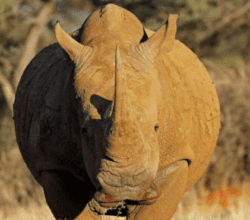edZOOcating: Northern White Rhinoceros Conservation Story
White rhinoceroses saw a massive decline in the 1500s when they were aggressively hunted for sport and their horns.
The northern white rhinoceros population continued to decline, dropping to 15 individuals by the 1980s. Today, they battle…
1
Poaching
For thousands of years, rhinoceros populations have been destroyed by hunting for their horns. Rhinoceros horns are made of keratin, the same proteins that make up our hair and nails but have long been thought to have medicinal value. It has been used to treat fevers, high blood pressure, food poisoning, and arthritis, though does not actually have any curing powers. Horns are also prized as trinkets and jewelry in some cultures. Today, poaching is the largest threat against rhinos, killing more than 900 per year and selling for $50,000 USD/lb.
2
Habitat Loss
Rhinoceroses have been pushed out of most of of their historical range due to the expansion of human settlements and agriculture in southern Africa. As humans move in and grow their communities, they need more resources and land to produce them. Overgrazing from herds of livestock and lumber needs resulting in deforestation, much of the white rhinoceros’s habitat is becoming uninhabitable. In order to have stable, self-sustaining white rhinoceros populations, you need a large and efficient habitat for them to roam.
Today, there are only two northern white rhinoceroses left in the world.
The mother and daughter pair named Najin and Fatu live in a conservancy in Kenya under 24/7 armed guard
How Did We Get Here?
After spending a long time under threat, the population of northern white rhinos was just over 2,000 individuals as of the 1960s. Civil wars and relentless poaching continued to decimate the rhino populations, leaving only about 15 individuals in a small region of the Democratic Republic of the Congo by the mid-1980s.
Through extreme concern for the survival of their subspecies, several organizations joined together to help recover the species. Over the next decade, the population of northern white rhinoceroses rose to roughly 30! With intense regulations and protections, their population remained stable until 2003, when a population survey only counted about 20 rhinos in the park.
A proposal to relocate a small group of the rhinos to a protected space was declined in late 2004 and because of park management issues and a lack of security, many organizations had no choice to but withdrawal from the recovery efforts. By 2006, only 4 northern white rhinoceroses remained and by 2007, there were no signs of a single rhinoceros.
Luckily for the northern white rhino, there were six remaining in captivity in the Czech Republic and it was time to get to work.
Saving the Northern White Rhino
In December 2009, four of the six captive rhinoceroses were moved from the Czech Republic to a conservancy in Kenya. Two others lived at the San Diego Zoo but were not eligible for breeding
The two male and two female rhinoceroses were moved in an effort to stimulate breeding behaviors being in a more natural environment
Breeding was unsuccessful and one of the males passed away from natural causes in 2014 and the other in 2018, making the natural reproduction process impossible
Biologists had been collecting reproductive materials from both males and female northern white rhinoceroses in the captive population. These sperm and eggs have been kept in “frozen zoos”
Reproductive materials have been shared from the San Diego Zoo, the Dvůr Králové Zoo in the Czech Republic, and the Ol Pejeta Conservancy in Kenya to provide as much opportunity as possible
Conservation Series
Explore conservation challenges, strategies, and successes happening in ecosystems all around the world! Discover new ways conservationists are thinking outside of the box and how you and your students can make a difference.




